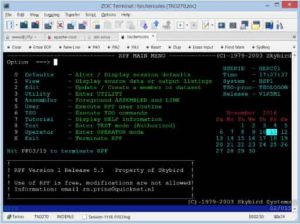

Click the arrow-down button on the tab strip and select Command Prompt. Switch Windows Terminal to the Command Prompt profile.Right-click the Start menu button and select Windows Terminal (Admin). Launch Windows Terminal with Administrator privileges.
#OPEN TERMINAL WINDOWS 7 HOW TO#
I FINALLY can quickly open it up now as I've always wanted to.Restore the default bootloader in Windows 11 How to Enable Legacy Boot Menu in Windows 11 The whole reason in the first place for me wanting to do this, was to be able to make a SHORTCUT of it so I could use my keyboard to open up my "My Documents" directory using a keyboard shortcut ("Ctrl-Alt-Shift-m"). Wish I had found your site long before I came upon it myself with what seems to be simply another way to open up the "My Documents" directory!Īnyway, I like your version of the trick too. I tried all sorts of things, Googling all sorts of various searches like "can't open My Documents folder from command line", etc.Īfter trying "start /?", and THAT not helping, and trying all sorts of commands, finally, I thought of trying "start explorer.exe \users\paul\My Documents" – AND THAT WORKED! All that would happen was that another command window would pop up. In a command prompt, I would get to the parent directory (c:\users\paul), and then type "start "My Documents". I had been looking and looking for some time on how to open the "My Documents" directory specifically.
#OPEN TERMINAL WINDOWS 7 FULL#
As a precaution make sure you have a valid full backup of your computer before changes are made. Registry Editor is a powerful tool, and if misused can cause your computer to become unstable or inoperable. Warning: If you are not familiar with Registry Editor, consider learning about how to use the Registry Editor before you get started. If you are missing this option, you can add it to the context menu by following these steps: This trick is pretty cool and very useful for any command line geek.Īlso, at the beginning of this article, I mentioned the capability to open a folder location in a Command prompt, by Shift+right clicking on a folder and selecting " Command Prompt Here".ĭepending on how you upgraded or installed Windows, you may not see the option to select Command Prompt Here when right clicking on a folder. In the below screenshot, the root of C:\ is the parent folder of Windows. If you want Windows Explorer to open the parent folder of the current location, just type …and Windows Explorer will open to the folder location that you were in at the command prompt, and display it's contents. Note: above command is typed as start, followed by a space, followed by a period. In the below screen shot I have cd to the Windows folder. Navigate to the folder you want displayed in Windows Explorer by using the Change Directory command " cd" (with out the quotes). To do this, open a command prompt from the keyboard by typing Win+R, or click on Start \ Run then type cmd in the run box and click OK.


 0 kommentar(er)
0 kommentar(er)
